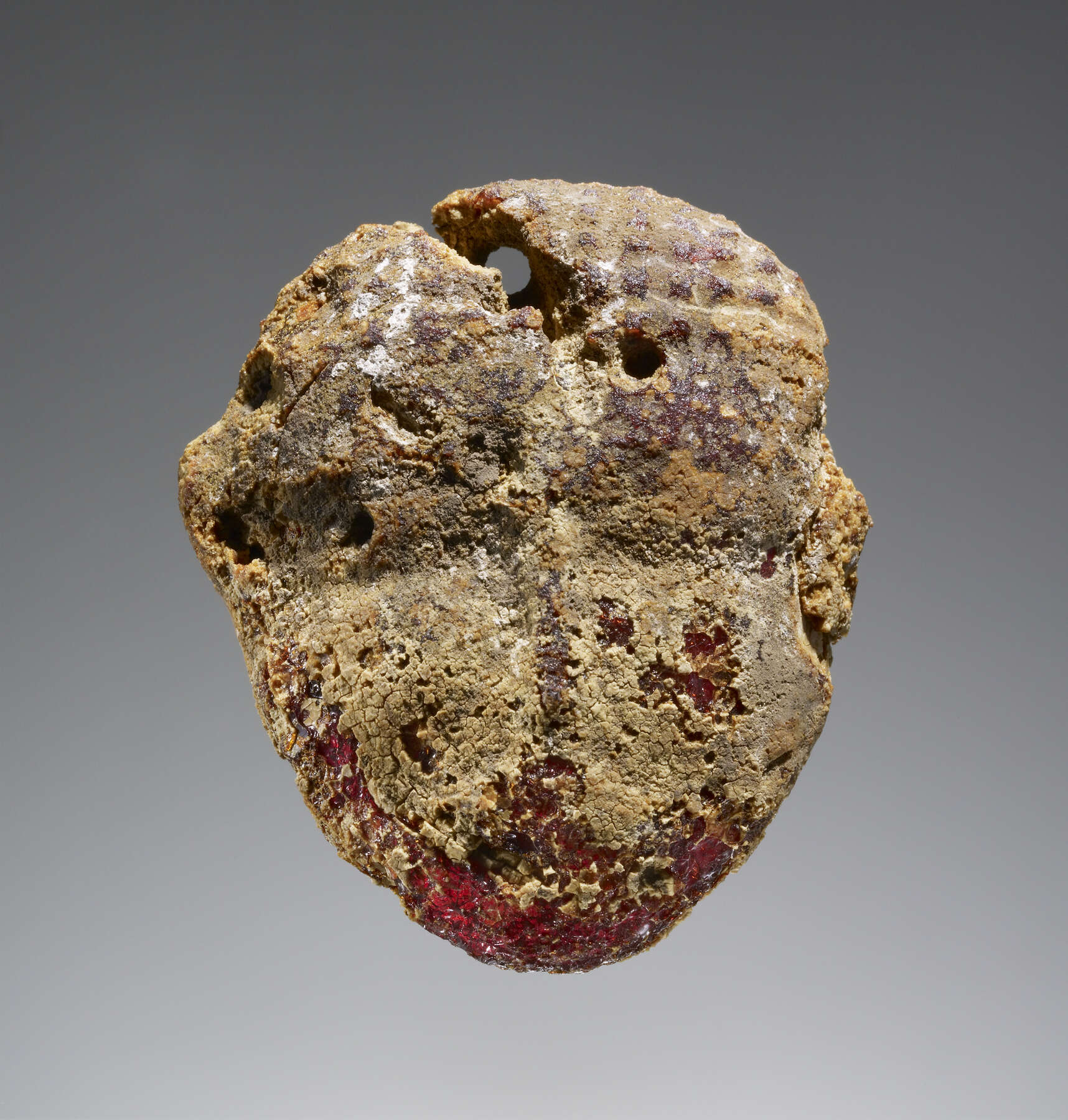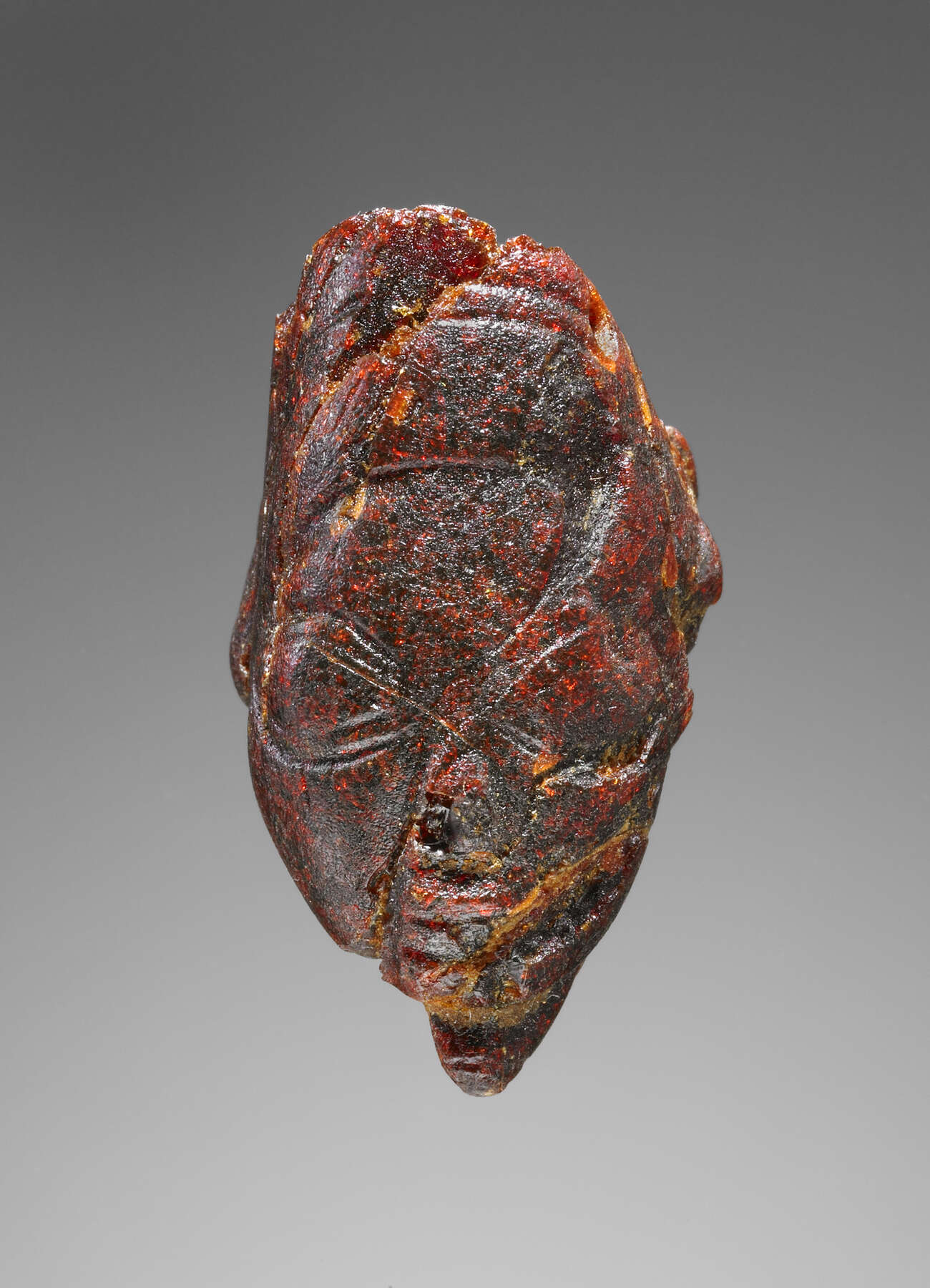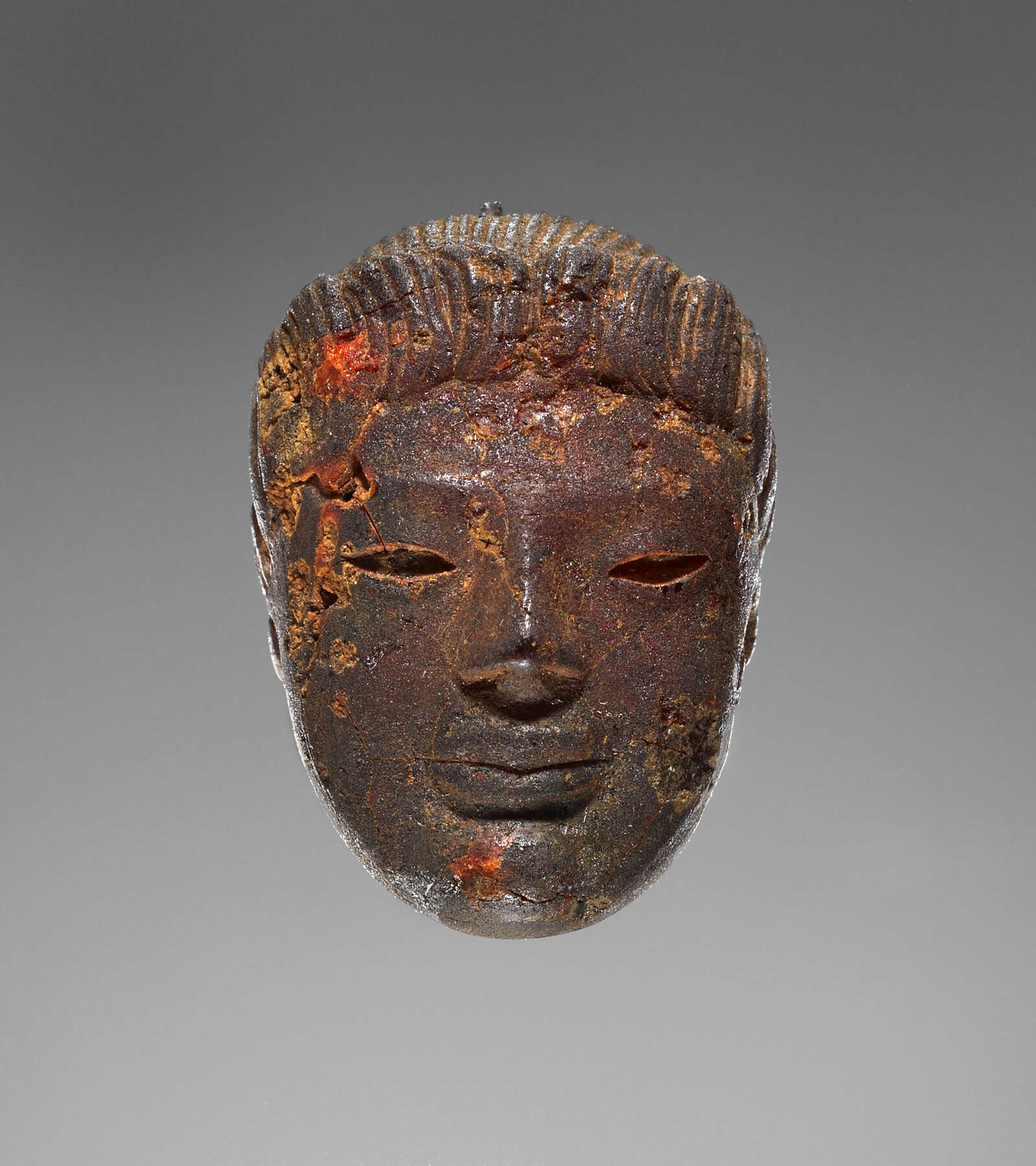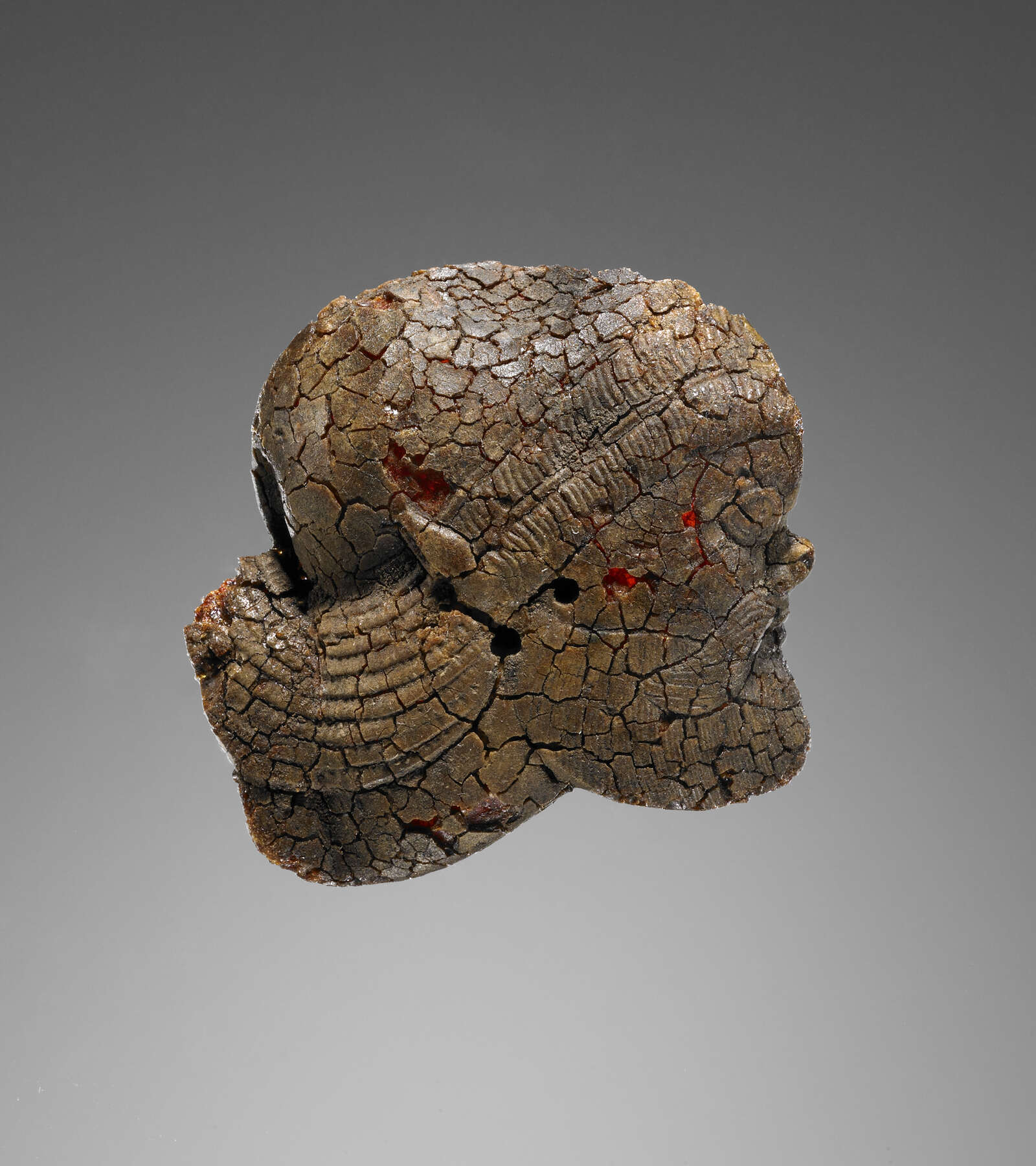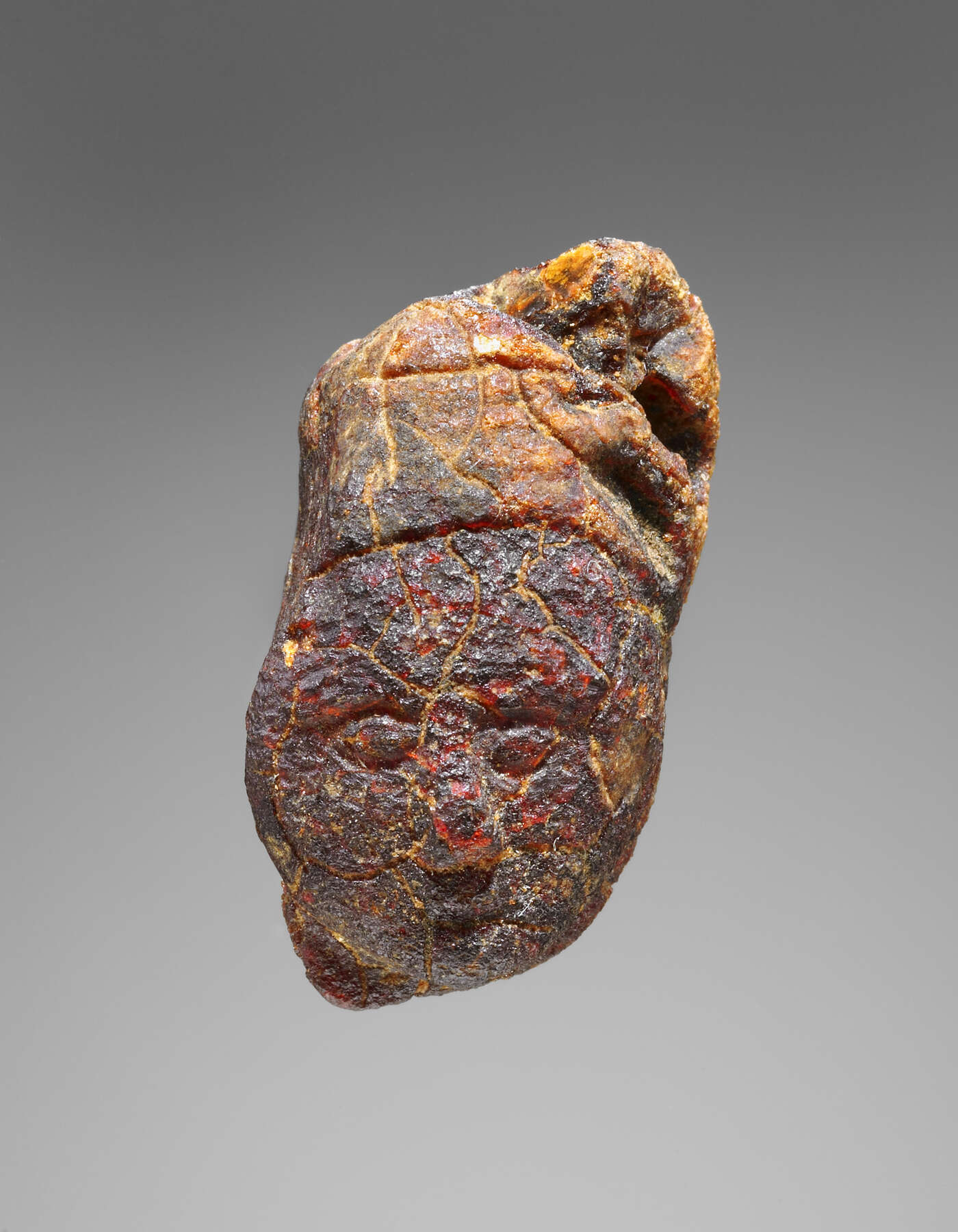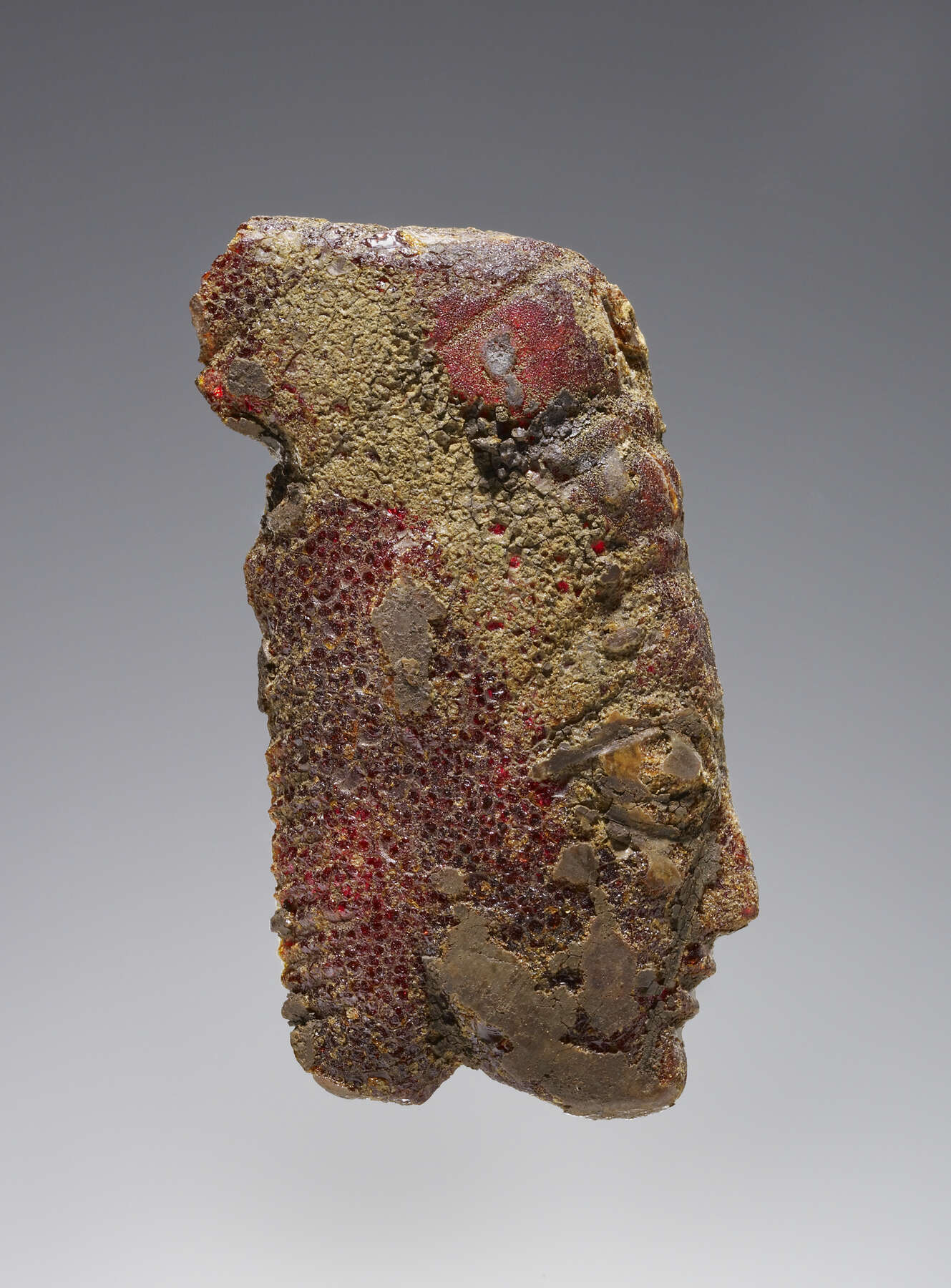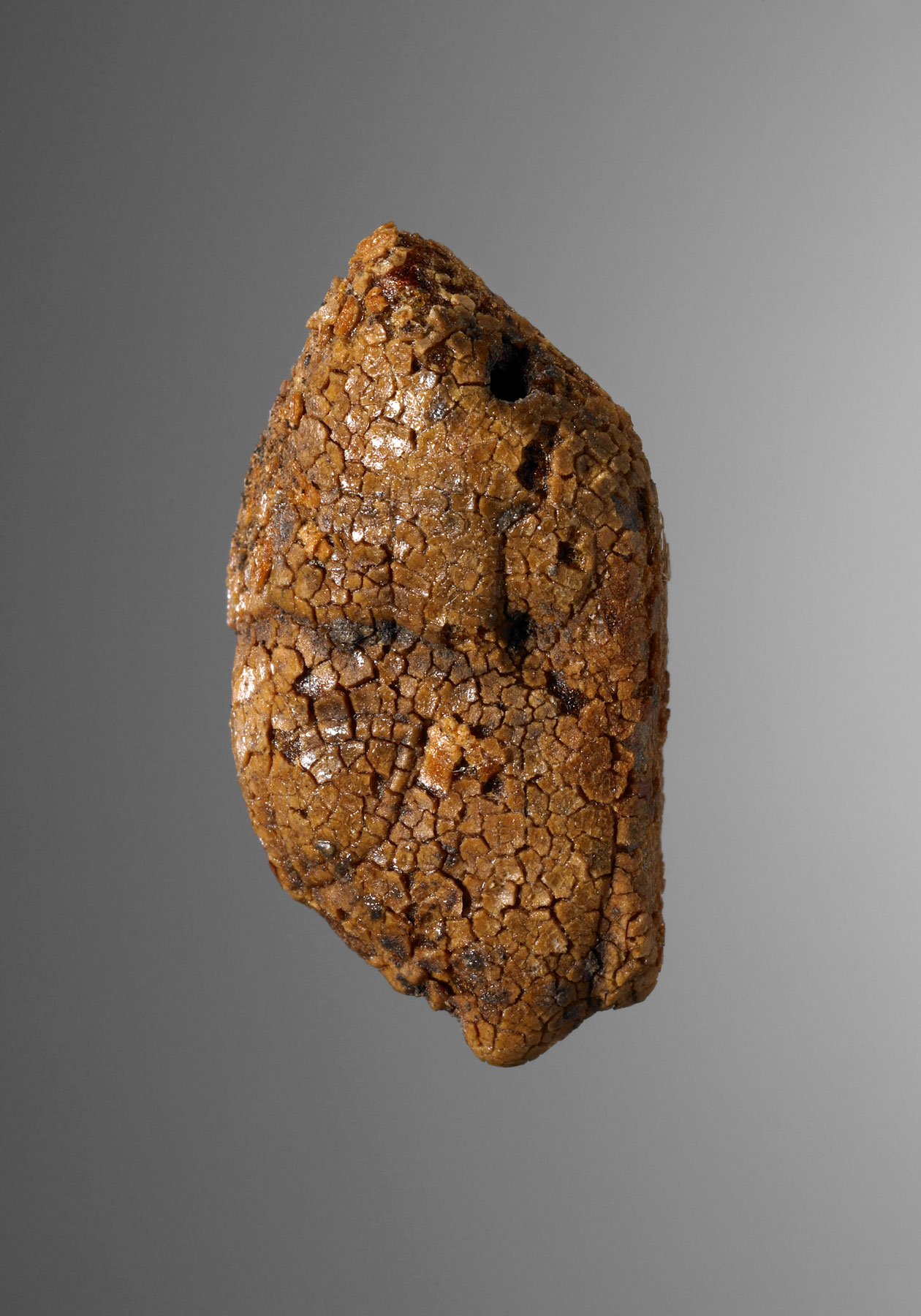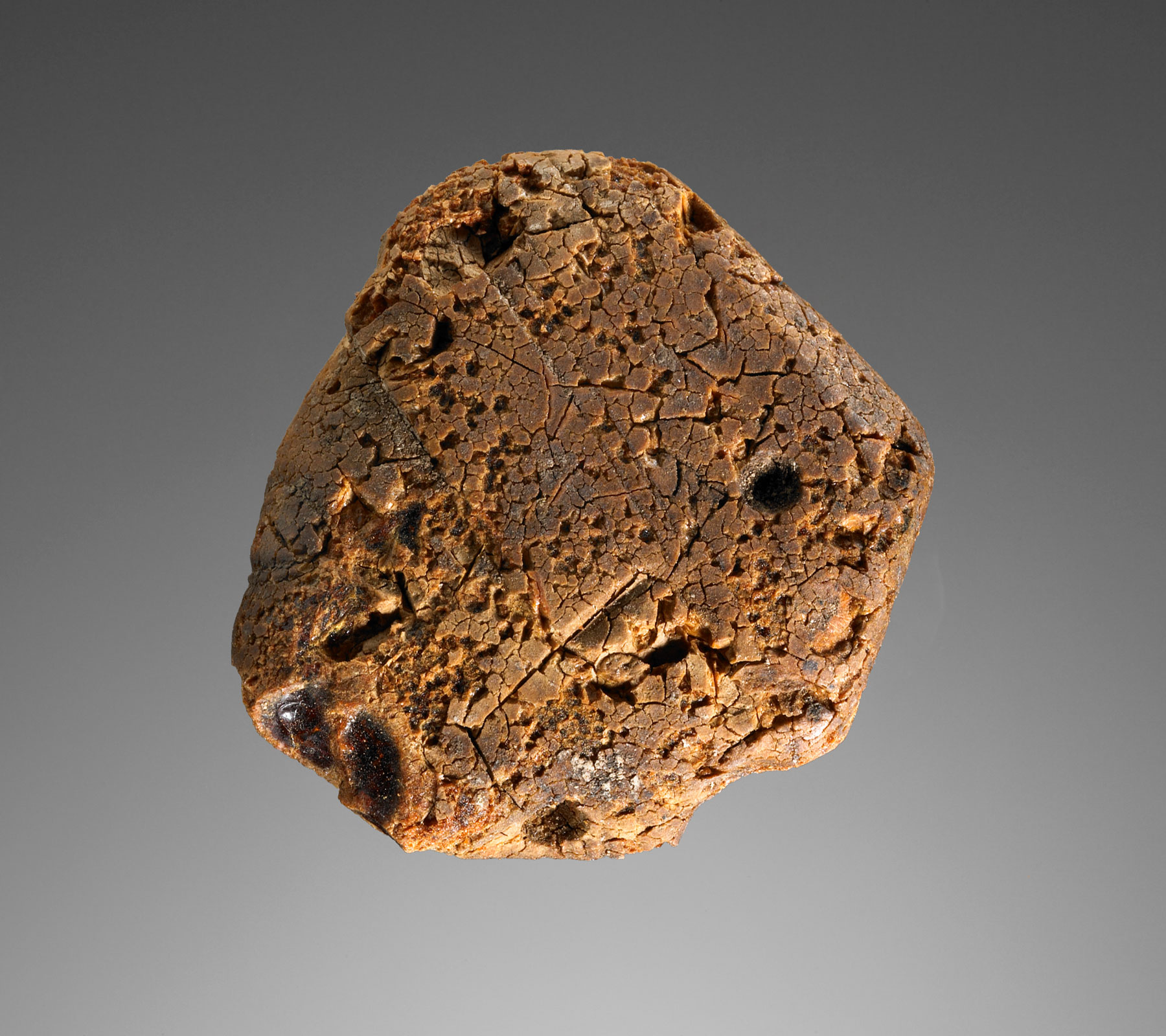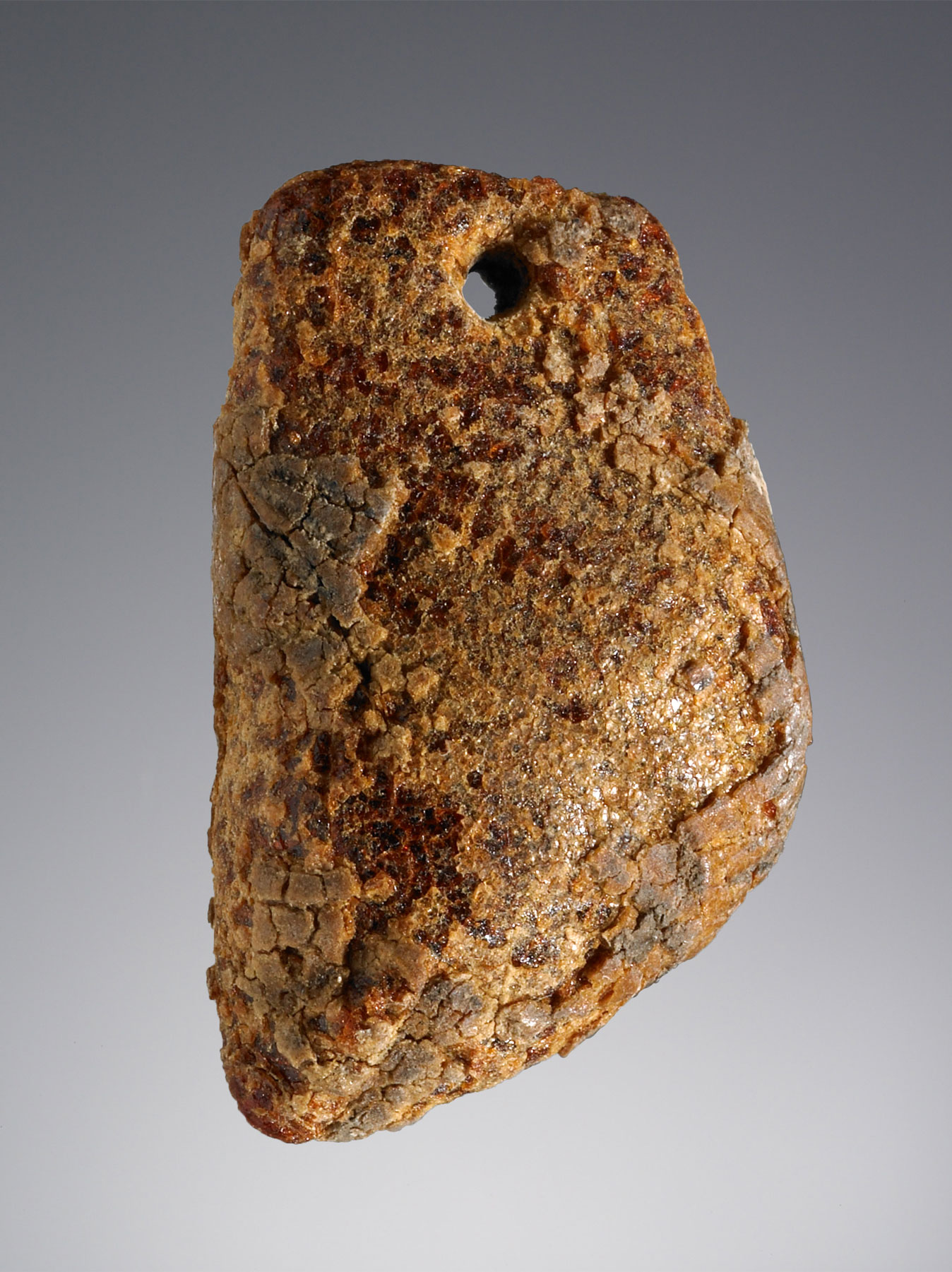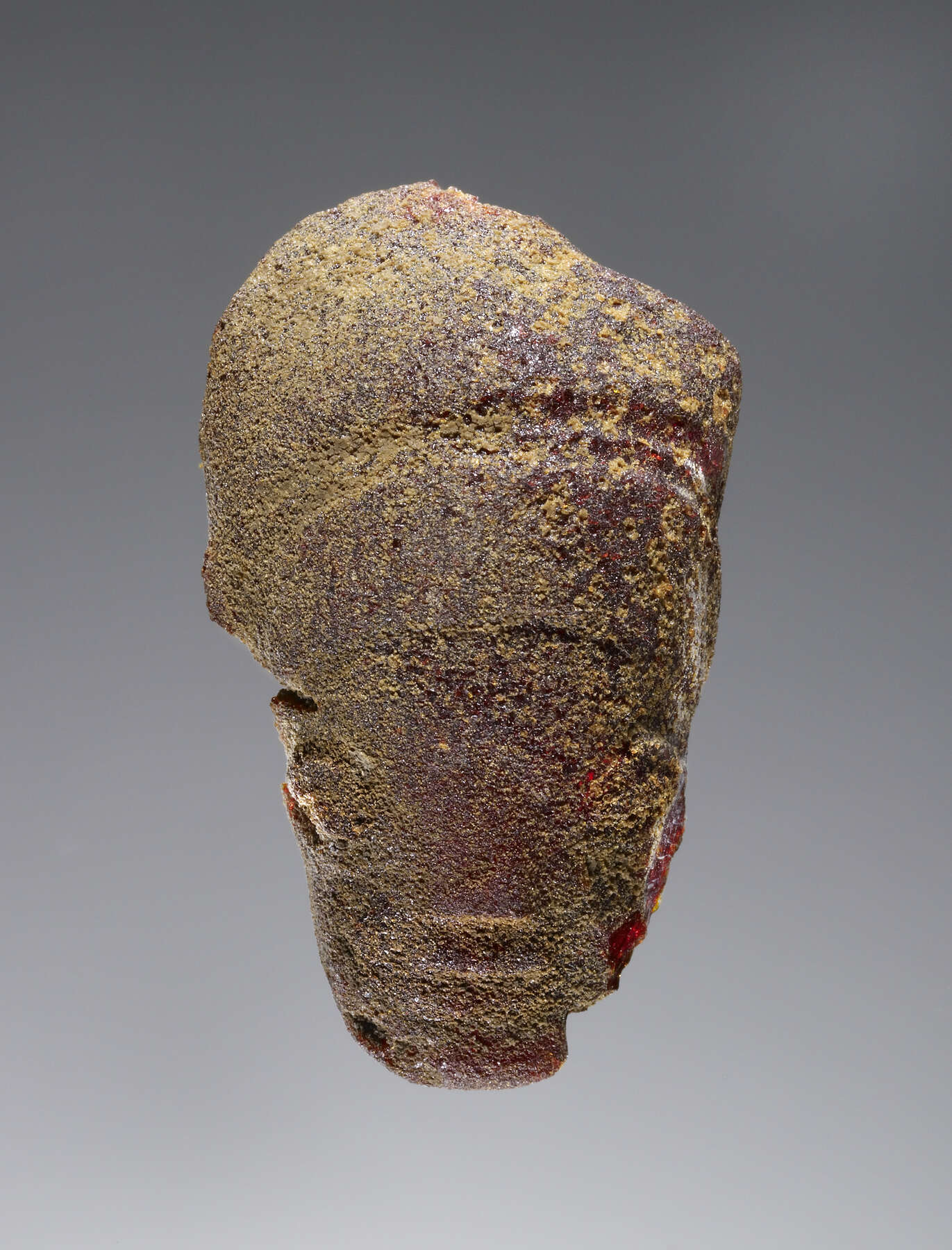The human head is the most common of all amber pendant subjects and enjoyed the longest duration, from the late eighth to the late fourth century B.C. From the beginning, they appear to follow a much older convention, whereby one part of a figure is sufficient to represent the whole. The symbolic meaning of the detached head as a pendant varies according to its type and use, but the head always represents a demon, hero, or divinity.
In this catalogue, I refer to this type as “head-pendants.” These can be divided into four basic schemata: a frontal face that is plain on the reverse; a complete head (the neck or a part of the neck is included, and the pendants are made to hang frontally); a frontal head with the neck included, but a plain reverse side; and a profile head with the neck included, the reverse plain, and the pendant made to hang in profile. Female subjects (humans or anthromorphs), with dressed hair, ornaments, or head coverings, and satyrs are found in all four schemata. Heads of indeterminate sex (probably representing youths or sphinxes), Herakles in a lionskin helmet, and bearded male heads with human ears occur only in the form of a frontal face with no neck, like a mask, the strongest form of the facing head motif.1 This is also the case with the rarely represented gorgoneion, the frontal face that precedes the appearance of the whole Gorgon in ancient art.2
All head-pendants of Greece and ancient Italy used in adornment have ancient small-scale antecedents in the art of Egypt, the greater Near East including the Syro-Phoenician area, and the Aegean, as well as in the image making of Ice Age Europe. The antecedents are of the utmost significance for the amber head-pendant: it should be seen as a late manifestation of a millennia-old tradition of wearing miniature decapitated heads, or heads pars pro toto, made in materials of high value, on the head, around the neck, or on the upper torso (and much more rarely elsewhere on the body).
The earliest surviving head-pendants in amber date to the late eighth century B.C., but they became more widespread during the second half of the sixth century, the same period in which the subject of a detached head was popular in other media, from architectural decoration to vessels and coinage. The format of the earliest documented en face amber head-pendant is very like that of the earliest Sumerian and Egyptian detached heads. The Sumerian profile heads used in inlays (various materials) date concurrently with the earliest Sumerian ornament-amulets in the form of frontal heads and faces. The frontal heads are in two basic types, those without horns (identified as goddesses) and those with bull horns (identified as gods). The earliest Egyptian amulets in the form of detached heads are flat-backed, front-facing heads and are exclusive to the late Old Kingdom and the First Intermediate period. Carol Andrews summarizes their appearance: short beard, prominent ears, and a suspension projection on the top of the head; made predominately of cornelian. Each is “intended to give its wearer the use of the senses in general.”3 Related to this type is another: human-head scaraboids, current from the New Kingdom onward. The enhancement of the scarab—the amulet par excellence of new life, regeneration, and resurrection—with a human face augmented its properties.4 Mycenaean objects with detached heads include engraved gems and metal vessels. A signal Minoan work is the bead in the shape of a human head in the Jewel Fresco at Knossos.5 The heads of female and male figures made of faïence (glazed composition) from Apadana, Mari, and other sites in Mesopotamia dating to the late second millennium B.C. must have had great influence on the development of the head-pendant as ornament and amulet.6
Antecedents for the amber head-pendants from Etruscan tombs are the protomes embossed in North Syrian metalwork, such as those on the bronze paterae and cups interred in the Barberini Tomb at Praeneste (those on the cups are winged);7 the faces of possibly Syro-Palestinian Tridacna squamosa shell figure-vessels, alabaster and stone cosmetic palettes, and ostrich-egg and other Oriental oinochoai;8 the human heads on Etruscan bucchero vessels with relief decoration;9 and the two types of ivory faces from the Barberini Tomb (the bearded faces and the single perhaps female face).10
The female heads on some late-eighth-century B.C. Cretan and Cycladic gold objects may be the direct ancestors of the earliest amber head-pendants. These include the frontal heads attached to a crescent-shaped gold pendant from the Khaniale Tekke Tomb from near Knossos,11 and three gold “buttons’” from a tomb at Megara (and a related pendant from Naxos in Berlin).12 Contemporary with these gold ornaments are the earliest surviving amber head-pendants: a pair of indeterminate sex from the sacred deposit at the temple of Artemis at Ephesus, and three undocumented faces from Italy (perhaps Vetulonia), that of a youthful female(?) figure whose hair is braided back from the brow, an unbearded, helmeted figure, and a female divinity (possibly) who wears an elaborate bird headdress.13
The next generation of frontal heads and faces includes the numerous seventh-century precious metal objects made in East Greece and Etruria. These include objects where the face is the single image, and others in which the face or detached head is one of many. Two objects exemplify the pervasiveness of this imagery: a pair of Etruscan armlets from Vetulonia, whose two terminal registers are made up of trios of faces (perhaps those of sphinxes), and an electrum temple pendant from Cameiros, a complex work that includes two frontal heads at the top.14 Numerous bone and ivory protomes from East Greece and Sparta date to this period.15 Although they are not independent works, the amber faces set into ivory and bone reliefs—a Laconian ivory sphinx and a pair of Laconian winged fertility divinities, flanked by smaller figures—should be mentioned.16 The detached female heads protecting a number of sanctuary-dedicated Greek bronze vessels of the seventh century are related in both subject and function:17 the female protective goddess represented on a vessel support from Olympia18 is probably the same divinity as the one gazing outward from the Rhodian metalwork19 and the early ambers. In addition, noteworthy seventh-century analogues for the gold, ivory, and amber heads are those represented on early electrum coinage.20
Although there are many instances of detached heads in seventh-century art, especially in East Greece, Crete, and Etruria, the subject was more widespread during the next century. The prominence of the detached head in Etruscan imagery, such as the so-called Canopic heads on the “metopes” of Caeretan dolii, or terracotta architectural decorations (on antefixes and raking simas), indicates the significance of the subject.21
The importance of the detached head in early-sixth-century Italy is indicated by the variety of materials in which it is found, the range of its use, and its geographic distribution.22 The amber head-pendants of the sixth century gained currency at the same time that the subject was more frequently employed in other media: in Greek vase painting; in early Greek facing head coinage;23 on contemporary gemstones; as precious metal adornment worn directly on the body (as on a necklace)24 or attached to dress, or as ritual headgear;25 as an attachment on bronze vessels; in architecture, as antefixes and on the raking sima; as the subject of terracotta votives; and for small votive(?) bronzes.26 A key amber of this period is the early-sixth-century head of a female figure (a siren or sphinx) wearing a slope-sided hat, excavated from an amber-rich grave, Tomb 96 at Chiaromonte–Sotto la Croce.27
Further study of the female heads on Etruscan Orientalizing metal reliefs and Etruscan bucchero and on Greek and Etruscan vessels, thymiateria, and lamps,28 as well as of the bearded male heads and demonic figures of “Phoenician” glass pendants—and their relationship to the early amber heads from Italy—should reveal a related purpose and iconography. They all must represent danger-averting divinities, heroes, and fantastic beings.
Amber head-pendants of the second half of the sixth century were made during a period of considerable amber availability in Italy, but most are small, from 10 to 50 mm. Notable examples are the six female faces from a tomb at Eretum: a frontal head-pendant of a woman from Certosa, two frontal female head-pendants from Tomb 102 at Braida di Vaglio (Basilicata), the Getty Head of a Female Divinity or Sphinx (, cat. no. 10), and two heads (one possibly male) in the Louvre.29 The earliest of the profile amber head-pendants date to the second half of the sixth century. From that point onward, until their virtual disappearance in the last quarter of the fourth century B.C., female subject head-pendants in both profile and frontal format coexist.
Just after the mid-sixth century, the first male head-pendants appear, first satyrs (in both facing and profile formats) and then, a few decades later, faces of the Cypriote-type Herakles and a type of unbearded males with human ears. The latter two types are uncommon. There are no male heads with bull’s horns, a not uncommon subject in other media.30 The earliest examples of satyr-subject head-pendants are the Getty Satyr Head (, cat. no. 13) and a trio (found together) in a New York private collection.31 The satyr-subject head-pendants precede ambers representing full-bodied Bacchic revelers (perhaps all satyrs) by at least a decade, if not more, in the early fifth century, and continue to be a popular subject until the early fourth century B.C., when figured ambers ceased to be made. From their earliest appearance in Greek art, and enduring in popularity throughout late antiquity, satyr heads were considered especially efficacious in averting danger, evil, and particularly the evil eye.32 In Italy and in Etruria especially, they were frequently employed as antefixes, often coupled with female heads, usually identified as maenads. Satyrs, in Etruscan art of the sixth century onward, were present in sacrifice scenes, and, as Jean-René Jannot points out, it is not clear whether this alludes to a cult of Dionysos or to one of nature more generally.33
The other identifiable male subjects of head-pendants include the unbearded Herakles in a lionskin helmet. Other male types are images of bearded males with naturalistically shaped ears and a number of unbearded faces of indeterminate sex that seem to represent youths. The latter, though nameless, probably represent heroes or divinities appropriate to the material of amber. Apollo is a good candidate; the god was worshipped as the Averter of Evil (Greek: Alexikakos, Apotropaios), the Protector (Epikourios), and the Purifier (Katharsios).34
Eye size varies among the earliest head-pendants of the seventh and sixth centuries: in some the eyes are naturalistically scaled; in others they are huge, staring, and rimmed with heavy lids. From the fifth century onward, large, “old-fashioned” staring eyes are the norm for both profile and frontal head-pendants, with the exception of a few classes, notably one attributed to Canosa and another to Campania.
From their earliest appearance, female head-pendants wear their hair elaborately dressed. In addition, they wear one or more kinds of head decoration or covering, sometimes in complex combinations: bands, crowns, caps, hats (various styles of poloi and various cone-shaped styles), kekryphaloi (kerchiefs), wrappings made from strips of cloth (sometimes over hats), and veils or other drapery-type head coverings. Not only are the facial types and artistic styles diverse, but the grooming and adornments also differ. Headgear, hairstyles, and jewelry vary, and the ambers in the Getty collection include most of these variants. A number of the female head-pendants, in various kinds of dress, are carved with a wing or wings. Among the earliest is a large profile head, (cat. no. 15). The winged head-pendants vary in type. Some, such as , represent a youthful female. Others, such as (cat. no. 23), represent a heavier-faced, mature, and unsmiling type.
Most amber female head-pendants wear headgear in the Archaic Ionian Greek or Etruscan fashion, as most modern students of the material have commented. The figures are dressed in the manner of the elite—sometimes they are clearly divine or heroic figures, sometimes actual persons; in other cases, they represent persons in ritual roles as votives, celebrants, and offerants. Parallels are found in Greek, Campanian, and Etruscan art, for both style and dress, such as the women painted in Etruscan tombs and on vases, molded in relief on Etruscan bucchero or terracotta antefixes, engraved on Etruscan mirrors, or made into small bronzes, many of which are votives.
The findspot and context of only a small percentage of the hundreds of facing and profile amber heads that have come to light since the nineteenth century are documented, and of these, even fewer were excavated under controlled conditions. Seventh-century examples are few but are recorded as coming from sanctuaries where they were dedicated to the Greek divinities Aphrodite, Artemis, and Apollo Daphnephoros. The recorded examples of sixth-to-fourth-century date almost all came from female grave contexts (those of women or children), and in only one case from an Italic sanctuary, that of the goddess Mefite (a goddess with kourotrophic and chthonic powers), who is identified with Aphrodite/Venus.35
The identities of the various female figures represented in the amber head-pendants are still an open question. A number of proposals have been put forward, all with the apparent assumption that in every case, similar-looking heads represent the same being. A female goddess, a protective genius, or a maenad—these are some of the hypothesized identifications.36
In the view of this author, amber head-pendants represent a variety of beings, including divinities, supernaturals, and demons, and the identities are not fixed. The material of the head-pendants, the amber, seems to preclude identifying them as images of their owners, or even of mortal mourners. Although it is unlikely that the head-pendants represent votives, supplicants, or offerants—identifications often made for related figures in other media, such as Etruscan bronzes—it is still possible that they may do so in light of ethnographic analogies. Amber female head-pendants were made over centuries and descend from different iconographic types. The same image type may have been used to represent different beings, depending on the circumstances. In the case of buried heirlooms or prestige gifts, it is possible that a treasured piece may have had several owners and even different identities over time.
Roger Moorey’s recent words about the identity of terracotta idols are pertinent to this vexing issue. In his Schweich Lectures, he proposed of anthropological research that
in the first place it highlights the fact that figures of similar appearance may have represented different beings, natural or supernatural; that the same type of figurine might have multiple functions; and that in one assemblage the same type might have had more than one function. In the second place, it indicates that terracotta anthropomorphic figurines do not have to conform to the tendency to regard them as necessarily representative of supernatural beings.… They may have embodied aspects of prevailing ideologies, whilst also reflecting contemporary society by encoding a variety of ritually significant knowledge relevant to the world of man and nature.… In light of ethnographic analogies … clay figurines do not have to conform to our expectations for them to be representations of supernatural beings or forces rather than of living human beings acting as votaries or worshippers or perhaps of dead human beings as ancestors or ghosts.37
Attributes may have modified the basic types into more individualized representations. The addition of a wing or wings, a diadem, or a necklace might signal an aspect of a divinity or demon and act as a determinant. Just as is the case with votive terracotta heads, the types might be modified by additions or adjustments. Identical terracotta votives may in one circumstance represent the offerant, in another, the divinity, and in still others, both at the same time—since the gods were represented in human form.
That the amber head-pendants are made from a potent material traditionally employed for divine, demonic, and heroic subjects, a material valued for its protective, apotropaic, and regenerative aspects, seems to limit the range of possible identities to certain female divinities, nymphs, protective geniuses, guides or psychopomps, demonic anthromorphs such as a sphinx or siren, spirits or souls, and, possibly, magical subjects like Medea or Circe.
What is critical is how these head-pendants might “work.” The bodiless heads and faces were pars pro toto of the full body, and thus held special power. A head alone could convey the hieratic implications of the complete body. The facing head and the frontal eye—an excerpt of the facing head—were highly potent foci and functioned apotropaically.38 The glaring eye, guarding against danger and averting evil with its “terrifying gaze” (phobon blepon), underscores the protective role of the image.39 The number of head-pendants with large (disfiguring) holes in the faces may be critical evidence for one kind of use and identity. It is possible that they were disfigured by drilling in order to nullify the possible negative powers of the image.40
The identifiable pendants of Herakles are of the Cypriot type and underline the renowned potency of the immortal hero-divinity: Herakles is a savior and a healer, a protector of springs, and a danger-averting deity (in Etruria, his close connection with Uni clearly establishes him thus). In each of the amber Herakles heads, he is frontal and wears the skin of a lion, a symbol of his strength, prowess, and deadly force. His glaring eyes emphasize his affinity with wild and dangerous fauna: he could be deinon paptainein (terrible to behold). In the one instance where the context of the Herakles head-pendant is known, its figured amber counterpart is a satyr, servant of Dionysos.41 This juxtaposition of ambers parallels the subjects of the main gate at Thasos, Herakles on one side with drawn bow and Dionysos on the other with the thyrsus.42 The two dangerous gods acted as guardians of the city.
An electron amulet of Apollo might well connect his fiery missiles with amber’s solar origin. Apollo, Herakles, and Artemis, Apollo’s twin—the three bow-bearing gods—were, for good and ill, death dealing. The divine twins were sharp shooters in their murder of Niobe’s children; the twin gods could also deliver peaceful deaths to the elderly.43 What better all-around amulet than one that could protect, ward off death and danger, promise rebirth, and heal? (Apollo’s son is Asclepius; fiery amber could function sympathetically to ward off fever; Apollo is one of the deities powerful for both the living and the dead.)
The dual natures of deities like Herakles and Dionysos or Artemis and Apollo are often played up in their iconography: their power to protect is directly related to their powers of destruction. In Italy, and specifically in Etruscan religion, the deities powerful for this life, the transition to the afterworld, and the afterlife itself were critical to funerary imagery. A special role was reserved for those deities with light and rebirth aspects. Erika Simon illuminates this eloquently: “Thus also the Etruscans wished their dead to have light. They gave them amulets with astral symbols and painted the holy laurel grove of Apulu/Usil on the walls of their tombs.”44
Notes
The origins of the facing head must lie in the efficacy of the severed heads of real animals positioned as trophies in public or cultic places. In P. Erhart Mottahedeh’s view (, pp. 274–75),
there exists no better vehicle for conveying hieratic and demonic associations. Deity and demon alike were most powerful and impressive if encountered face to face, and in pictorial art only the facing head allowed direct confrontation between image and viewer. The facing head was, in effect, the pictorial equivalent of the cult image in the round. It could express more ably than the profile head the presence or actuality of deity or demon, for immediacy was potency. From earliest times the facing head motif reveals a fundamental duality and polarity in art; it exhibits, so to speak, two faces—one hieratic and godly, the other demonic and monstrous. Opposed to the profile head, it can assume either a positive or a negative role, signifying good or evil, sacred or profane, and similar polarities. This duality and polarity of the facing head motif was engendered by ancient religious beliefs in an elemental godhead which combined polarities—one both threatening and protective, beautiful and monstrous, fertile and barren.
She continues, “Its strongest form is the Mask, which is able to capture essence alone, undiluted by activity.… The motif was initially reserved for highly symbolic figures.… For human figures it served to strengthen divine nature, while for certain animals and hybrid creatures it served to underscore demonic force.” For other discussions of the mask form and its apotropaic role, see the sources listed in , n. 198; , pp. 196–97; , pp. 37–38; and, most important, . , p. 97, discusses the eyes and masks of late-sixth-century B.C. Greek cups and amphorae. While he admits that they “may have had their original stimulus in magic or cult,” he believes that their “meaning can be found in the realm of humour.” However, he does not address the importance of humor as a time-honored aversion technique.
↩- On Gorgo, Medusa, and the gorgoneion, see W. A. P. Childs and D. Tsiafakis in ; R. Mack, “Facing Down Medusa (An Aetiology of the Gaze),” Art History 25, no. 5 (2002): 570–604; S. R. Wilk, Medusa: Solving the Mystery of the Gorgon (Oxford and New York, 2000); , n. 199 (with other relevant bibl. not listed here); J.-P. Vernant, “Death in the Eyes: Gorgo, Figure of the Other,” pp. 114–15, and “In the Mirror of Medusa,” pp. 141–51, in Mortals and Immortals: Collected Essays by Jean-Pierre Vernant, ed. F. I. Zeitlin (Princeton, 1991); 4 (1988), s.vv. “Gorgones” and “Gorgones in Etruria” (I. Krauskopf); and . ↩
- , p. 69. ↩
- The scarab is the Egyptian solar subject par excellence. It represents the morning manifestation of the sun-god. , p. 51, outlines: “Because of the underlying ideas inherent in its shape, the scarab form of itself offered the hope of new life and resurrection, but these magical properties could be enhanced even further by the inscription motifs or pictorial representations added to the flat underside.” Amuletic scarab seals can also have human elements, and a human head with hair can replace the whole back, as on scaraboids produced in the Naucratis faïence factory at the end of the seventh and in the sixth century B.C.: V. Dasen, “Squatting Comasts and Scarab-Beetles,” in , p. 91. Dasen establishes that the image of scarab beetles was associated with Dionysos (p. 95, with essential bibl., including her Dwarfs in Ancient Egypt and Greece [Oxford, 1991] and ). Two other Egyptian amulet types relevant for the amber head-pendants are the faces of Bes and of Hathor. The relationship of the heads of Meskhenet to Greek and Etruscan female head representations may also prove significant. The head of Meskhenet was “frequently attached to a type of brick that Egyptian women crouched upon when giving birth. Meskhenet was also believed to appear at the time of an individual’s death—perhaps to preside over ‘birth’ into the afterlife—and the goddess is sometimes depicted in this way in vignettes from the Book of the Dead”: , p. 41 (with reference to E. Russman, Egyptian Sculpture: Cairo and Luxor [Austin, TX, 1989], pp. 19–21, 214, n. 5). ↩
- , p. 63, fig. 9. ↩
- For the faïence head-pendant from Susa (Apadana) in the Louvre (Sb 03588), see Faïences de l’Antiquité: De l’Égypte à l’Iran, exh. cat. (Paris, 2005), p. 65, no. 159. The following are all in the Louvre and illustrated in the above-cited catalogue: example from Ougarit (Minet el-Beida, Tomb VI, AO.15731), no. 154; two from Mari (Tomb 236, AO.19078, and Tomb 255, AO.19488), nos. 155–56; the other two from Mesopotamia (AO.07089, AO.06685), no. 157. ↩
- Large bowl mounted on three legs, Rome, Museo Nazionale Etrusco di Villa Giulia 13131, from the Barberini Tomb, Praeneste: C. Densmore Curtis, “The Barberini Tomb,” Memoirs of the American Academy at Rome 5 (1925): 42–44, no. 79, pls. 26–27. ↩
- For the engraved Tridacna squamosa shell figures, sirens(?), falcons, and other creatures, see the recent discussion in B. Brandl, “Two Engraved Tridacna Shells from Tel Miqne-Ekron,” Bulletin of the American Schools of Oriental Research 323 (2001): 49–62 (with earlier bibl., including R. A. Stucky, The Engraved Tridacna Shells [Sao Paulo, 1974]; A. Rathje, “A Tridacna Squamosa Shell,” in Italian Iron Age Artefacts in the British Museum: Papers of the Sixth British Museum Classical Colloquium, ed. J. Swaddling [London, 1986], pp. 393–96; and D. Reese and C. Sease, “Some Previously Unpublished Engraved Tridacna Shells,” Journal of Near Eastern Studies 52 [1993]: 109–28). For the other imported vessels, see A. Rathje, “Oriental Imports in Etruria in the Eighth and Seventh Centuries: Their Origins and Implications,” in ; and A. Rathje, “Some Unusual Vessels with Plastic Heads on Their Necks,” in Studia Romana in Honorem Petri Krarup septuagenarii, ed. K. Ascani (Odense, 1976), pp. 10–19. The head on the umbo of the British Museum shell (GR 1852.112.3) is identified as that of a woman on the museum’s website. ↩
- For example, the bowl with twelve human heads from the Tomb of the Painted Lions, Cerveteri, third quarter of the seventh century B.C. (Rome, Museo Nazionale Etrusco di Villa Giulia 13234): , fig. 39. ↩
- Rome, Museo Nazionale Etrusco di Villa Giulia 13396 (bearded males) and 13421 (female; possible sphinx) from the Barberini Tomb, Praeneste: M. L. Uberti, “Gli avori e gli ossi,” in , pp. 404–21, 743, nos. 935–36; M. E. Aubet, Los Marfiles orientalizantes de Praeneste (Barcelona, 1971), pp. 165–68, pl. 25; and Curtis 1925 (in n. 7, above), pp. 31, 101–2, nn. 47–49, pl. 10. ↩
- Heraklion, Archaeological Museum: , pp. 243–44, no. 53.2. ↩
- Paris, Louvre 13638: ibid., p. 246, no. 60 (with references). ↩
- The youthful face is in a private collection in Basel. In the Metropolitan Museum of Art are the helmeted male pendant, 1992.11.14b, and the female bird-hatted divinity(?), 1992.11.14a (both are Purchase, Renée E. and Robert A. Belfer, Patti Cadby Birch and The Joseph Rosen Foundation Inc. Gifts, and Harris Brisbane Dick Fund, 1992). ↩
- For the armlets in Florence (Museo Archeologico Nazionale 92600–92601), see , pp. 137, 280, no. 96; for the complex electrum temple ornament, with rosettes, poppy flowers, a nude, necklaced female, a lion’s face, and two frontal heads, in Paris (Louvre S 1208), , p. 121, no. 80, with bibl. ↩
- See . For the plaquettes from Cameiros, Rhodes, in the British Museum (Jew. 1103-6, 1108), see , pp. 85–87, pl. XI. ↩
- For the sphinx appliqués with amber faces from a couch in the Iron Age Celtic tomb at Grafenbühl, Asperg (Stuttgart, Würtembergisches Landesmuseum), the key first publication is H. Zürn and H. V. Hermann, “Der ‘Grafenbühl’ auf der Markung Asperg, Kr. Ludwigsburg, ein Fürstengrabhügel der späten Hallstattzeit,” Germania 44 (1966): 83, 100–102, pl. 12. Later discussion includes , pp. 83–85, (with a critical assessment); J. Fischer, “Zu einer griechischen Kline und weiteren Südimporten aus dem Fürstengrabhügel Grafenbühl, Asperg, Kr. Ludwigsburg,” Germania 68 (1990): 120–21; J.P. Mohen Trésors des princes celtes, exh. cat. (Paris, 1987), pp. 24–26; B. Shefton, “Zum Import und Einfluss mediterraner Güter in Alteuropa,” Kölner Jahrbuch für Vor und Frühgeschichte 22 (1989): 214, n. 34; , pp. 84–85; A. Mastrocinque, “Avori intarsiati in ambra da Quinto Fiorentino,” 10 (1991): 3ff. (where he assigns the Belmonte Piceno appliqués to the same atelier as the Asperg sphinx, and points to a Tarentine manufacture); and , p. 389 (which identifies the place of manufacture as Picenum and the style as Laconian, but without ruling out Greek, possibly Tarantine, workmanship). For the Picene plaques with standing winged divinities between acolytes, see , pp. 82–85, nos. 135–36, pls. XLIV–XLV. ↩
- , pp. 154–58, nos. 88–101. ↩
- For Olympia Br 10881 (Athens, National Archaeological Museum 6201), see W. Gauer, “Gerät- und Gefässefüsse mit Löwenpranken und figürlichem Schmuck aus Olympia,” 99 (1984): 38–40. ↩
- Among the plaquette-ornaments (garment decorations; closures?) is a group of eight silver-gilt objects from Bologna (Aureli necropolis, Tomb 11) dating to the last quarter of the seventh century B.C. (Bologna, Museo Civico Archeologico 25681–88): , pp. 362–63, no. 517. Is the severe and unsmiling figure Potnia Theron? ↩
- For early electrum coinage with faces and heads, see, for example, ; and R. W. Wallace, “The Origin of Electrum Coinage,” 91 (1987): 385–97. ↩
- Among the earliest heads used as antefixes in Etruria are the Potnia Therons from the Orientalizing “workshop” building at Poggio Civitate: see E. Nielsen, “Interpreting the Lateral Sima at Poggio Civitate,” in , pp. 64–71. W. A. P. Childs in , p. 64, proposes Artemis for the female heads interspaced with gorgoneia at the early temple of Hera at Corfu. N. A. Winter, Greek Architectural Terracottas from the Prehistoric to the End of the Archaic Period (Oxford, 1993), pp. 62–63, reiterates, albeit with skepticism, the proposal by M. Torelli (“Terrecotte architettoniche arcaiche da Gravisca e una nota a Plinio, NH XXXV, 151–52,” Nuovi quaderni dell’Istituto di archeologia dell’Università di Perugia 1 [1979]: 307–8) that two Cretan immigrants to Italy invented antefixes decorated with heads. F. Kenfield, in his review of Winter (Bryn Mawr Classical Review 94.11.05), finds the Cretan-origin hypothesis attractive. On the subject of identity and meaning, Winter proposes that female-headed antefixes represent sphinxes. Kenfield calls attention to M. Mertens-Horn, “Una nuova antefissa a testa femminile da Akrai ed alcune considerazioni sulle Ninfe di Sicilia,” 66 (1991): 9–28, where she proposes an alternative interpretation specific to Sicilian female head antefixes. Kenfield suggests, “Female head antefixes could have different meanings in different places.” The same is possible for the female amber head-pendants, and for comparable reasons. The metope-stamped dolii include a right-facing bearded male head, but no female heads or other female subjects, as L. Pieraccini makes clear in “A Storage Vase for Life: The Caeretan Dolio and Its Decorative Elements,” in Etruscan Italy: Etruscan Influences on the Civilizations of Italy from Antiquity to the Modern Era, ed. J. F. Hall (Provo, UT, 1996), pp. 92–113. ↩
- For the origin and religious significance of the terracotta protome, see , p. 18. On the origin of the Etruscan terracotta votives, see . ↩
- For early Greek coinage, see, for example, ; and , pp. 20–29. Relevant examples are the “Apollo” staters from Colophon, the silver Aegean Dionysos type, and two electrum “satyr” types, from Phocea and Cyzicus, and the Cyzicus Athena head. The following comparable gemstones are illustrated in : the chalcedony lentoid from Melos in Boston (Museum of Fine Arts 27.678) with a facing satyr (p. 137, pl. 274); the pale green steatite pseudo-scarab with a crowned double head (one bearded, one unbearded) in London (British Museum 480) from Cyprus (p. 180, pl. 281); also in London (British Museum 492), the Island pseudo-scarab of green steatite with a back in the form of a frontal satyr face, signed by Syries (p. 184, pl. 350); and the Greek pseudo-scarab of carnelian made in Etruria with Dionysos on the back in Boston (Museum of Fine Arts LHG 35 ter), by the Master of the Boston Dionysos (p. 186, pl. 408). ↩
- Some examples are the sixth-century B.C. gold head-pendants (female?) on a necklace found at Ruvo di Puglia in Taranto (Florence, Museo Archeologico Nazionale 6429): , p. 52, 191, CII A 1 (necklace), and pp. 71–73, 228, PV2 (pendants). ↩
- The silver-gilt frontal heads (and the kore, acorns, and lion’s head) from a tomb in Taranto (Florence, Museo Archeologico Nazionale 12024–31) may have decorated a polos; there are no traces of holes for attachment, and they were presumably “glued on.” For the group, see , pp. 106–8, 266, 332, L IV A 1. Comparable heads (female heads, gorgoneion, Herakles’ face) are in the Getty Museum (96.AM.110–415: , pp. 122, 126–27), and a group of four (one male and three females) allegedly from Policoro are in the Ortiz collection, Geneva: In Pursuit of the Absolute: Art of the Ancient World—from the George Ortiz Collection, exh. cat., rev. ed. (Bern, 1996), no. 123. Several other heads were said to be found with this group. ↩
- Two small bronzes, an Archaic female head in Toronto and a Severe-style male head in New York (which also has a suspension loop in the top of the head), are apparently both from Italy. See S. Haynes, “A Bronze Head from South Italy,” in Miscellanea Etrusca e Italica in onore di Massimo Pallottino 43 (1991): 96–99. ↩
- For the head (inv. 210442), see , p. 45; and , p. 15, fig. 7, no. 152. ↩
- Two comparable ritual objects of seventh-century B.C. date are the terracotta lamp from Gela with rams’ heads and polos-wearing female heads (Museo Archeologico Regionale di Gela 7711: P. Orlandini, “Gela: La stipe votiva del Predio Sola,” 46 [1963]: 33–41, no. 1, figs. 14–16, pls. 8a–c, 9a–b) and the marble lamp from the Selinuntine Malophoros sanctuary (Museo Archeologico Regionale “A. Salinas” di Palermo 3892: , pp. 292–93, no. 75). ↩
- For the amber heads from Eretum, see ; for the Tomb 102 Braida di Vaglio heads (Potenza, Museo Archeologico Nazionale “Dinu Adamesteanu” 95201, 95204), , p. 40, nos. 136–37, pl. XLVI. The amber heads in the Louvre (originally pendants?) are modern additions to a gold bracelet (Louvre Bj 2347). The heads are separately inventoried as Louvre Bj 23471 a and b. Bj 23471 a is probably a male figure, as comparison with the bronze votive kouroi in Richardson’s Middle Archaic Series A (Florence, Museo Archeologico Nazionale 62, 63, 68, 84 [from Arezzo]) suggests. The hairstyle of Bj 23471 b is comparable to that of contemporary sphinxes, such as the sphinx on an Etruscan gold fibula from Vulci in Munich (Antikensammlungen 2338): , pp. 183, 296–97, no. 171. ↩
- It is significant that there are no extant amber head-pendants of male figures with horns, considering how popular the subject of a horned, bearded male figure is in pre-Roman art, in goldwork and ivory, and as a device on early coinage. This lack is even more surprising given the existence of four complete amber pendants in the form of recumbent bull-bodied, bull-horned anthromorphs, one in London (British Museum 68 [“Achelous?”]), another in Paris (Louvre Bj 2123), a third in New York (Metropolitan Museum of Art 1992.11.57, Purchase, Renée and Robert A. Belfer Philanthropic Foundation, Patti Cadby Birch, and The Joseph Rosen Foundation Inc. Gifts, and Harris Brisbane Dick Fund, 1992), and a fourth in a Geneva private collection. The style of the four taurine ambers is Ionian influenced; they have few comparanda apart from East Greek plastic vessels in the form of similar creatures. The full-body anthromorph types derive from the ancient Near Eastern bull-man and are often identified as Achelous (whose realm, as first stated in Hesiod’s Theogony, is streams and water), but could be identified as Eridanus. Their antecedent is the human-headed bison or bull-creature that was associated with the sun-god Shamash; it is linked with the eastern sunrise. Since amber has both solar and aqueous associations (ocean, river, and stream), these amber pendants, which follow a millennia-old compositional format, may incorporate both the ancient Near Eastern solar associations and the watery ones. The four amber bull-men pendants revert their heads and were perforated to hang head downward. Does this pose connect them to funerary use? On the early human-headed bison or bull-man, see P. Hansen in , pp. 230–31, nos. 157a–b. See also W. A. P. Childs, “The Human Animal: The Near East and Greece,” pp. 49–70 (with key references, including 1 [1981], s.v. “Acheloos” [P. Isler], p. 13, no. 1), and S. Gavel, “Human-Headed Bull,” pp. 108–10, no. 1, in . Both Gavel and Childs emphasize the iconography of the bull-man as protector of flocks and of the Tree of Life. , pp. 104–6, addresses issues relevant for the ambers in her analysis of Achelous images on early Greek coinage. ↩
- Unpublished. ↩
- In Roman times, the satyr mask was thought to be effective in warding off the evil eye: see M. Henig, “Roman Sealstones,” in , p. 99. , p. 557, discusses the use of heads in apotropaic imagery and gives the examples of the images of Hephaistos on the furnaces of bronze workers; the “laughable images” (geloia, called baskania), grotesque faces, and satyrs’ masks on other ovens; and bird and animal protomes on other structures, all used in protection against ill will (phthonos, sometimes translated as “evil eye”). Faraone also cites the fragment of a lost Aeschylean satyr play in which effigies (eidola and mimemata, exact portraits) of satyrs are fastened to the exterior of a temple, from which vantage point they will frighten off wayfarers. In the tenth century A.D., Al-Beruni (The Book Most Comprehensive in Knowledge on Precious Stones, trans. H. M. Said [Islamabad, 1989], p. 181) stated, “The only reason for liking [amber] is said to be that it averts the evil eye.” For the evil eye, see “Amber Medicine, Amber Amulets,” n. 152. ↩
- , p. 38. ↩
- , p. 277 (with reference to L. R. Farnell, The Cults of the Greek States, vol. 1 [Oxford, 1896]). ↩
- For the amber necklace with at least six heads from the Mefite sanctuary in Valle d’Ansanto in the Museo Irpino, Avellino, see , p. 210, n. 20; 30 (1976): 503–4, no. 1309g; and G. Colucci Pescatori, Il Museo Irpino (Cava dei Tirreni, 1975), p. 33, pl. IX. ↩
- suggests that the Lavello-Casino head-pendant may represent a protective deity (see cat. no. 55, n. 3). , p. 203, incline toward identifying the head-pendants as representing “a female goddess or protective genius.” , p. 151, wonders whether they might be maenads or nymphs, even perhaps the Heliades. ↩
- , pp. 7, 49. ↩
- On the facing eye, see ; and , p. 379. ↩
- , pp. 45, 58–59. ↩
- On the destruction of images to abort power, see ; and . ↩
- See “Amber Medicine, Amber Amulets,” n. 171. ↩
- , pp. 58–59. ↩
- . ↩
- E. Simon, “Gods in Harmony: The Etruscan Pantheon,” in , p. 48. ↩
Bibliography
- Andrews 1994
- Andrews, C. Amulets of Ancient Egypt. Austin, TX, 1994.
- First Cities 2003
- Aruz, J., ed. Art of the First Cities: The Third Millennium B.C. from the Mediterranean to the Indus. With R. Wallenfels. Exh. cat. New York, 2003.
- Bartoloni et al. 2000
- Bartoloni, G., et al., eds. Principi etruschi: Tra Mediterraneo ed Europa. Exh. cat. Bologna, 2000.
- Magna Graecia 2002
- Bennett, M. J., and A. J. Paul. Magna Graecia: Greek Art from South Italy and Sicily. Exh. cat. Cleveland, 2002.
- Boardman 2001
- Boardman, J. Greek Gems and Finger Rings: Early Bronze Age to Late Classical. New and enlarged ed. New York, 2001.
- Bottini and Setari 2003
- Bottini, A., and E. Setari. La necropoli italica di Braida di Vaglio in Basilicata: Materiali dallo scavo del 1994. With appendix by M. Torelli. 60, serie miscellanea 7. Rome, 2003.
- Carpenter 1986
- Carpenter, T. H. Dionysian Imagery in Archaic Greek Art: Its Development in Black-Figure Vase Painting. Oxford, 1986.
- Collon 1997
- Collon, D., ed. 7000 Years of Seals. London, 1997.
- Cristofani and Martelli 1983
- Cristofani, M., and M. Martelli, eds. L’oro degli Etruschi. Novara, 1983.
- Croissant 1983
- Croissant, F. Les protomés féminines archaïques: Recherches sur les représentations du visage dans la plastique grecque de 550 à 480 av. J.-C. 2 vols. Paris, 1983.
- D’Ercole 1995
- D’Ercole, M.-C. “Observations sur quelques ambres sculptés archaïques d’Italie méridionale.” 1995: 265–90.
- De Grummond and Simon 2006
- De Grummond, N. T., and E. Simon, eds. The Religion of the Etruscans. Austin, TX, 2006.
- De Puma and Small 1994
- De Puma, R., and J. P. Small, eds. Murlo and the Etruscans: Art and Society in Ancient Etruria. Madison, WI, 1994.
- Mottahedeh 1979
- Erhart [Mottahedeh], K. P. The Development of the Facing Head Motif on Greek Coins and Its Relation to Classical Art. New York, 1979.
- Faraone 1992
- Faraone, C. A. Talismans and Trojan Horses: Guardian Statues in Ancient Greek Myth and Ritual. New York, 1992.
- Frontisi-Ducroux 1991
- Frontisi-Ducroux, F. Le Dieu-Masque: Une figure du Dionysos d’Athènes. Paris and Rome, 1991.
- Gager 1992
- Gager, J. Curse Tablets and Binding Spells from the Ancient World. New York, 1992.
- Guzzo 1993
- Guzzo, P. G. Oreficerie dalla Magna Grecia: Ornamenti in oro e argento dall’Italia Meridionale tra l’VIII ed il I secolo. Taranto, 1993.
- Hölbl 1979
- Hölbl, G. Beziehungen der ägyptischen Kultur zu Altitalien. 2 vols. Leiden, 1979.
- Haynes 2000
- Haynes, S. Etruscan Civilization: A Cultural History. Los Angeles, 2000.
- Higgins 1980
- Higgins, R. A. Greek and Roman Jewellery. 2nd ed. London, 1980.
- Jannot 2005
- Jannot, J.-R. Religion in Ancient Etruria. Translated by J. Whitehead. Madison, WI, 2005.
- Kraay 1976
- Kraay, C. M. Archaic and Classical Greek Coins. London, 1976.
- Laffineur 1978
- Laffineur, R. L’orfèvrerie rhodienne orientalisante. Athens, 1978.
- Losi et al. 1993
- Losi, M., B. Raposso, and G. Ruggiero. “The Production of Amber Female Heads in Pre-Roman Italy.” In Amber in Archaeology: Proceedings of the Second International Conference on Amber in Archaeology, Liblice, 1990, edited by C. W. Beck and J. Bouzek, pp. 203–11. Prague, 1993.
- Magie d’ambra 2005
- Magie d’ambra: Amuleti e gioielli della Basilicata antica. Exh. cat. Potenza, 2005.
- Marangou 1969
- Marangou, L. Lakonische Elfenbein- und Beinschnitzereien. Tübingen, 1969.
- Marshall 1911
- Marshall, F. H. Catalogue of the Jewelry, Greek, Etruscan and Roman, in the Departments of Antiquities, British Museum. London, 1911.
- Mastrocinque 1991
- Mastrocinque, A. L’ambra e l’Eridano: Studi sulla letteratura e sul commercio dell’ambra in età preromana. Este, 1991.
- Moorey 2003
- Moorey, R. S. Idols of the People: Miniature Images of Clay in the Ancient Near East. Schweich Lectures. Oxford and New York, 2003.
- I Fenici 1988
- Moscati, S., ed. I Fenici. Exh. cat. Milan, 1988.
- Musti et al. 1992
- Musti, D., et al. L’oro dei Greci. Novara, 1992.
- Ornamenti e lusso 2000
- Nava, M. L., and M. N. Santi, eds. Ornamenti e lusso: La donna nella Basilicata antica. Exh. cat. Rome, 2000.
- Centaur’s Smile 2003
- Padgett, J. M., et al. The Centaur’s Smile: The Human Animal in Early Greek Art. Exh. cat. Princeton, 2003.
- Ridgway and Ridgway 1979
- Ridgway, D., and F. R. Ridgway, eds. Italy before the Romans: The Iron Age, Orientalising and Etruscan Periods. New York, 1979.
- Rocco 1999
- Rocco, G. Avori e ossi dal Piceno. Rome, 1999.
- Rolley 1996
- Rolley, C. “Sculpture in Magna Grecia.” In I Greci in Occidente, edited by G. Pugliese Carratelli, pp. 369–98. Exh. cat. Venice, 1996. Published in English as The Greek World: Art and Civilization in Magna Grecia and Sicily. New York, 1996.
- Smithers 1988
- Smithers, S. G. “The Typology and Iconography of Etruscan Terracotta Curotrophic Votives: The Heads and Bambini.” Ph.D. diss., University of Iowa, 1988.
- Steiner 2001
- Steiner, D. T. Images in Mind: Statues in Archaic and Classical Greek Literature and Thought. Princeton, 2001.
- J. Paul Getty Museum 2002
- The J. Paul Getty Museum, Handbook of the Antiquities Collection. Los Angeles, 2002.
- Tsetskhladze et al. 2000
- Tsetskhladze, G., A. J. N. W. Prag, and A. M. Snodgrass, eds. Periplous: Papers on Classical Art and Archaeology Presented to Sir John Boardman. London, 2000.
- Wilkinson 1992
- Wilkinson, R. H. Reading Egyptian Art: A Hieroglyphic Guide to Ancient Egyptian Painting and Sculpture. London, 1992.
- Winter 2000
- Winter, I. J. “The Eyes Have It: Votive Statuary, Gilgamesh’s Axe, and Cathected Viewing in the Ancient Near East.” In Visuality before and beyond the Renaissance: Seeing as Others Saw, edited by R. S. Nelson, pp. 22–44. Cambridge, 2000.

